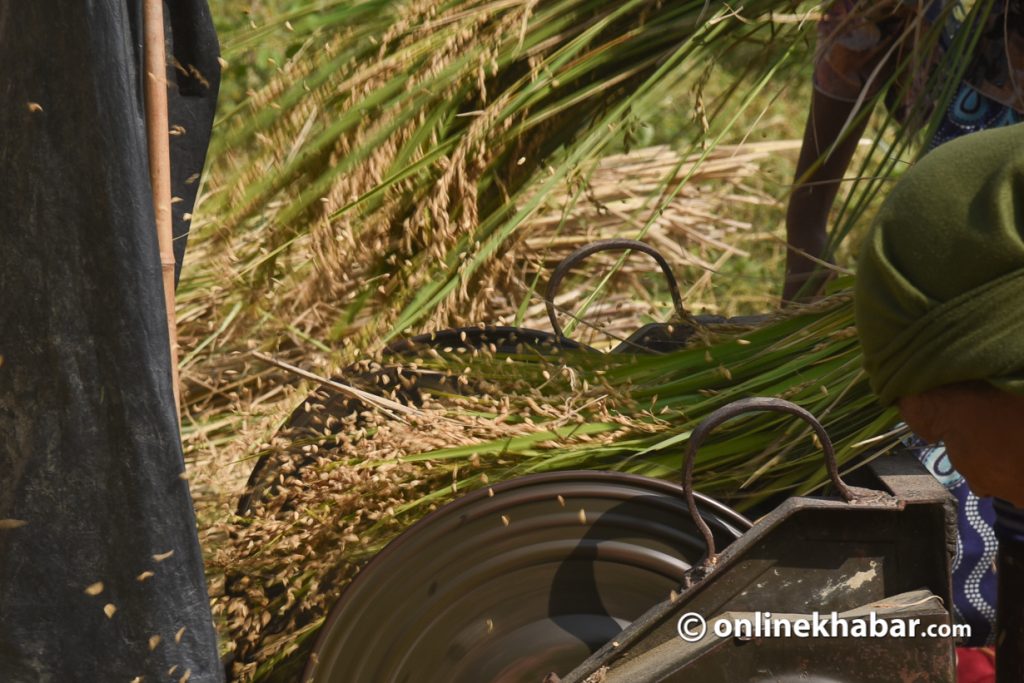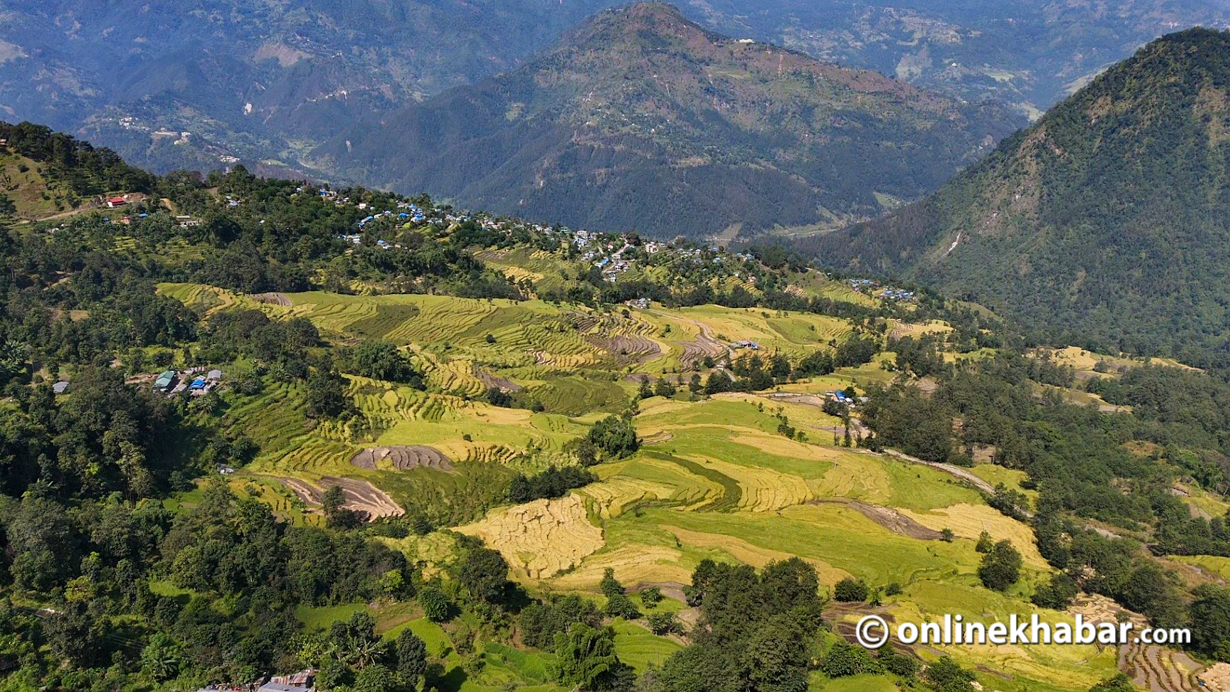
Currently, farmers across the country are out in their fields harvesting their crops. In the scorching sun, they are fully engaged in cutting, drying, and raking the paddy planted in June/July. As that goes on, the government, however, is deliberating whether to import rice that India has set as a quota for export as it is worried about the country’s rice production.
India in July imposed a ban on the export of non-basmati white rice. That caused a surge in rice prices in Nepal. As concerns arose regarding a potential shortage, the Ministry of Industry, Commerce and Supply approached India, requesting over 100,000 metric tonnes of rice to stabilise the prices.
Despite repeated requests from the Minister for Industry, Commerce and Supply, Ramesh Rijal, India set an export quota of 95,000 tonnes of rice on October 13.
An official from the ministry said, “ India ceased rice exports even during the shortage. The rice requested in June arrived three months later in September when the farmers across the country were busy harvesting, that too 5,000 tonnes short.”
Therefore, the ministry has been deliberating whether to accept the 95,000 tonnes of rice. Is our domestic rice production insufficient to meet our demands?
In response, Gajendra Kumar Thakur, spokesperson and joint secretary of the Ministry, stated, “Domestic production barely covers a 10-month supply. Additionally, Nepal’s newly established liquor industry also requires rice. In such a situation, the country faces the need to import rice.”
The connection with rice
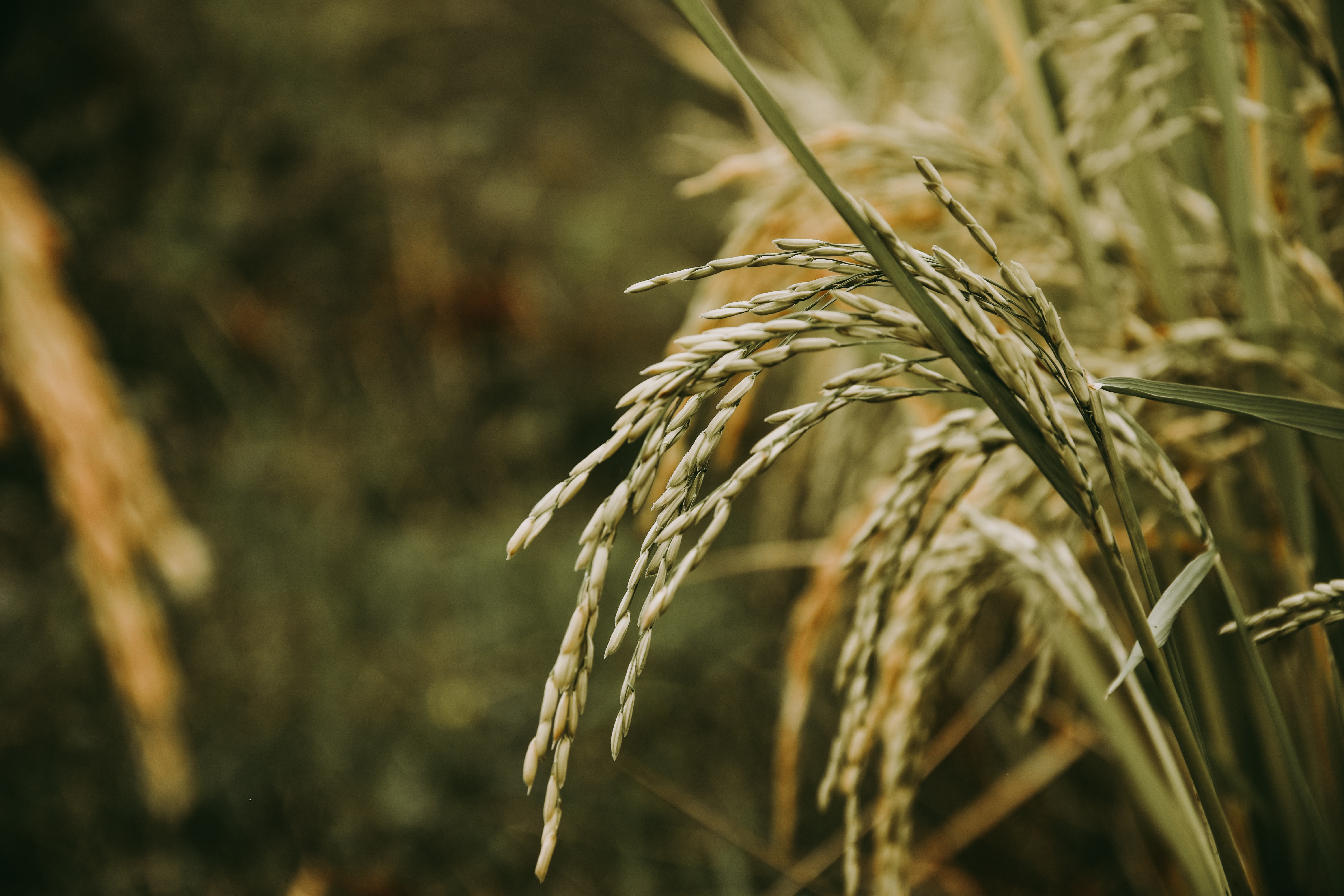
Even with India’s rice ban, Nepal imported 190,000 tonnes of rice worth Rs 5.6 billion in the current fiscal year. According to the Ministry of Agriculture and Livestock Development, Nepalis consume an average of 137 kilograms of rice per year, surpassing the per capita international consumption standard of rice, which stands at 121 kilograms.
Over the past 60 years, the growth in the population consuming rice has exceeded the rise in rice production. Ram Krishna Shrestha, joint secretary of the agriculture ministry, notes that the insufficient focus on prioritising advanced seeds, technology, and the development of rice cultivation has resulted in a substantial decline in both the number of farmers and the land area dedicated to rice cultivation.
Currently, the country needs around 2.4 million tonnes of paddy and rice annually. However, with the current growth rate, Nepal is projected to need 10 million tonnes of rice per year by 2035. Meeting this target requires an 80 per cent increase in rice production.
That is not going to be easy, especially considering that many lands are being left barren, coupled with a significant number of individuals leaving Nepal. The country is grappling with the adverse impacts of climate change, further complicating efforts to address the rising demand for rice.
The surging demand
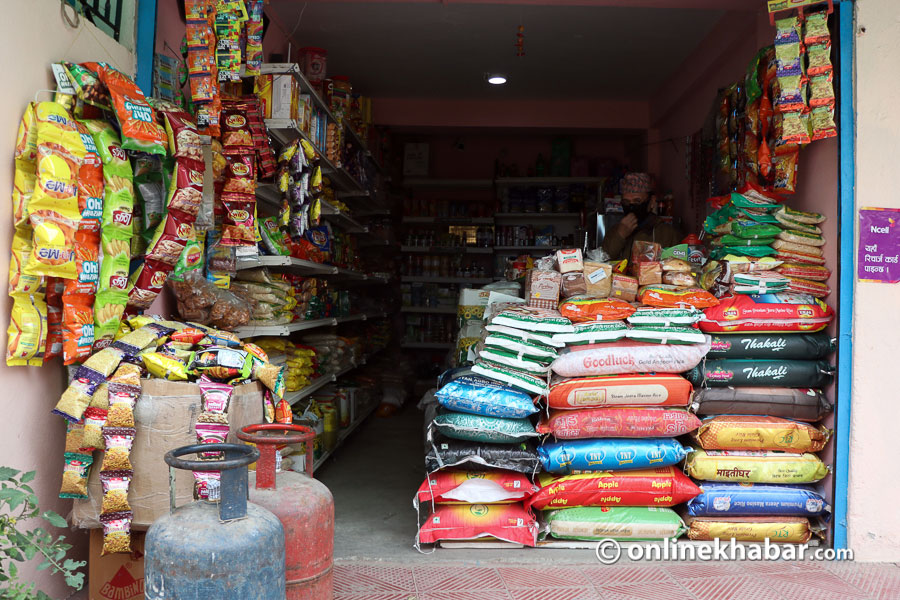
Various studies in the agricultural sector suggest that Nepalis are consuming more rice than necessary. The agriculture ministry reports that Nepalis are consuming 16 kilograms more rice per person annually.
Experts attribute this trend to the extensive use of rice and the subsequent decrease in production, resulting in a dependency on imports. The National Agricultural Research Council (NARC) states that the primary reason for this dependence is the inability to produce rice in accordance with Nepal’s growing population.
Dr Rama Krishna Shrestha, the Head of the Centre for Crop Development and Agro Bio-diversity Conservation under the Ministry of Agriculture, emphasises the immediate need to boost rice production. This step is crucial to diminish dependence on paddy and rice, thereby altering the dietary habits of Nepali people. He adds that 68 million tonnes of rice are required for consumption, while 10 million tonnes are used for purposes such as beverages, animal feed, and seeds.
Dr Sushil Subedi, the rice expert at the Centre, asserts that despite the increasing productivity of Nepal’s rice, it is insufficient to sustain the burgeoning population. Shrestha points out that over the past 54 years, the growth rate of rice productivity in Nepal has been 1.5 per cent, while the population has grown at 2.3 per cent.
Shrestha adds scientists have estimated a decrease in rice and other crop production worldwide due to climate change. Nonetheless, we are confronted with the challenge of augmenting production for food security. Nepal annually produces about 5.5 million tonnes of rice as opposed to approximately 7.9 million tonnes of rice to achieve self-sufficiency.
Limited area and productivity
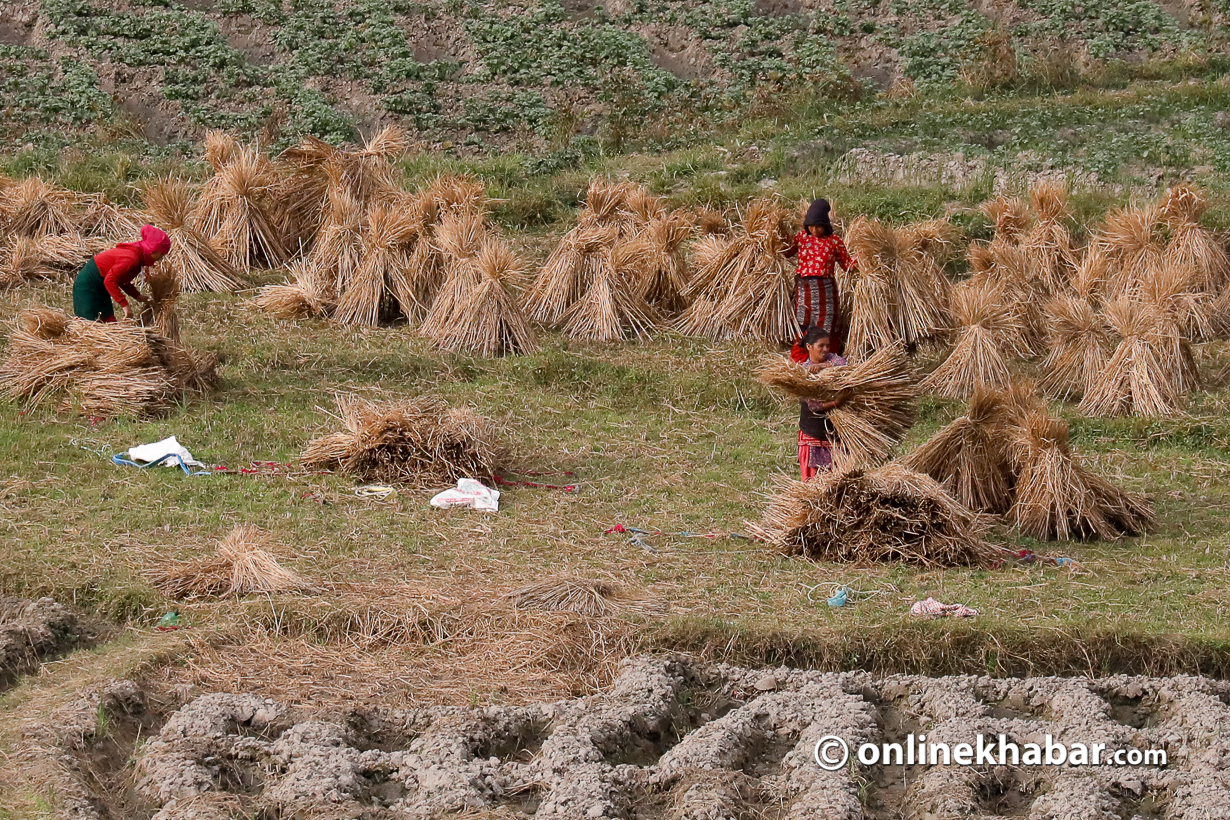
In the last 30 years, the workforce engaged in rice cultivation has increased, but there has not been significant progress in production. In 1991/92, 2.037 million families were involved in rice cultivation. By 2001/02, the number rose to 2.46 million and, in 2011/12, the number was 2.069 million. Today, there are 2.7 million families engaged in farming.
As per the government’s projection, this year was expected to see rice planted across 1.4 million hectares. However, by mid-September, only 1.3 million hectares had been cultivated. The data for this year’s rice production is yet to be released.
The rice cultivation was done in 1.481 million hectares 30 years ago, but the number decreased by 265,000 hectares in 2023. Comparatively, last year saw planting across 1.4 million hectares in Nepal, yielding 5.1 million tonnes of rice. In the fiscal year 2018/19, more than 1.4 million hectares were planted, increasing production. However, since then, neither the area of rice cultivation nor the production has seen an increase.
The productivity of rice in Nepal is 3.09 tonnes per hectare, whereas our neighbouring countries India, China, and Bangladesh outperform Nepal in rice production.
Recent data reveal that Nepal is falling behind not just in rice production but in all agricultural yields. The country’s lag in production stems from escalating market-oriented consumption, the rise in the market, migration of the labour force abroad, and remittances.
“Insufficient” budget
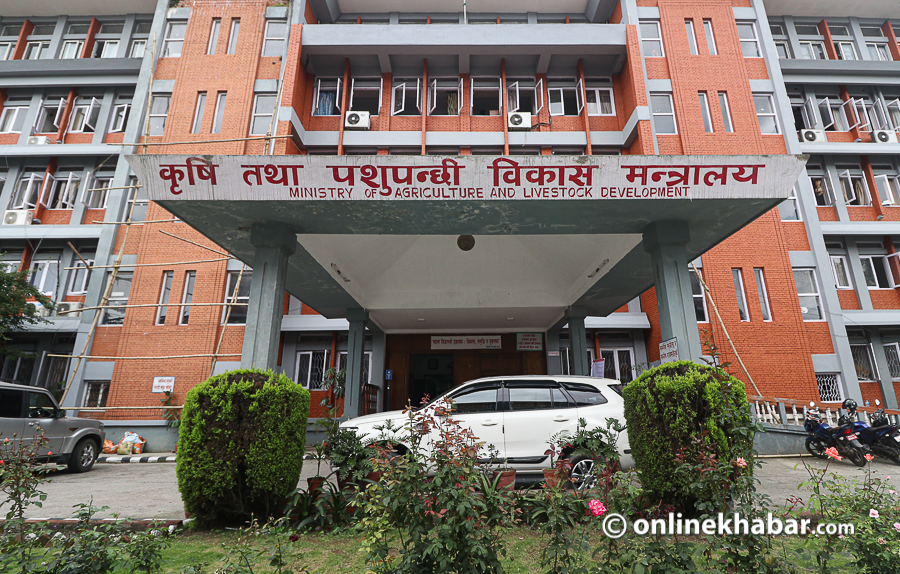
Nepal’s failure to match its agricultural potential is attributed to government negligence in safeguarding farmers, boosting productivity, and preserving agricultural investments. Agriculture Minister Dr Beduram Bhusal acknowledges this shortfall.
Expressing his concern about the deforestation of the flatlands used for rice cultivation, he says, “Overall, arable land must be conserved, and all necessary arrangements for production should be implemented.”
However, the current investment falls short of achieving this objective. The government has allocated Rs 58.95 billion for agricultural development. Of this amount, only Rs 30 billion has been set aside for the purchase of chemical fertilisers while the remaining Rs 28.95 billion can be utilised for current expenditure, accounting for 90 per cent of the budget allocation.
Ministry officials acknowledge that despite receiving the highest budget allocation for agriculture to date, there still is not enough funding to undertake significant work.
A ministry official says, “Food security is national security. Despite this, the government has yet to invest 5 to 10 per cent of the total investment in agriculture. Not only is there a lack of investment in rice, but also research and study centres associated with it are facing cancellations.”
In the past 10 years, the maximum investment in the agricultural sector from the total budget has hovered around 3.5 per cent. In the fiscal year 2013/14, the government allocated 3.77 per cent of the total budget to agriculture. This percentage decreased to 3.27 in 2014/15, further dropping to 2.63 in 2015/16, and reaching 2.61 in 2016/17. The allocation plummeted to 1.19 in 2017/18, while it reached 2.27 in 2018/19, 2.57 in 2019/20, 2.54 in 2020/21, 2.67 in 2021/22 and culminating 3.12 in 2022/23.
During this time, the budget indicates an increase from 1.19 per cent to 3.77 per cent. However, the noticeable increase lies in the overall budget size rather than solely in agriculture. The sector, which received a budget of Rs 21.4 billion in 2013, has seen an increase to Rs 58.5 billion this year.
Officials expressed concerns about insufficient government investment in agricultural research, advanced seed development, irrigation infrastructure construction, product procurement, and the establishment of market management infrastructure.
Focus on seeds

Minister Bhusal has been instrumental in promoting spring rice to attain rice self-sufficiency since assuming office. The Centre also supports the potential of spring and hybrid rice for achieving this goal.
Utilising just 18 per cent of the irrigated area year-round for rice cultivation currently, increasing it to one-third could significantly boost Nepal’s rice production. Joint Secretary Shrestha advocates for expanding spring rice production to cover 33 per cent of the total rice cultivation area, potentially doubling rice cultivation.
Shrestha stressed the need tp boost productivity fivefold by expanding fertilisation, technology, and irrigation. Additionally, he highlights the need to increase the coverage of hybrid rice from the current 14 per cent to 25 per cent nationwide.
Additionally, Shrestha suggests raising the proportion of milled rice production from the current 17 per cent to about 50 per cent, emphasising the need for dietary and production adjustments.
Recent discussions at the Ministry of Agriculture revealed plans by the Ministry of Irrigation to extend irrigation to 100,000 hectares of land. Minister Bhusal assured active efforts to support farmers by setting fair prices for rice purchase, including support prices for irrigation, seeds, and storage of produced rice.
Officials from the Ministry of Agriculture and Livestock Development emphasise that increasing rice production is not solely the responsibility of the Ministry of Agriculture. They propose allocating land for rice production should fall under the Ministry of Land. Similarly, irrigation matters should be handled by the Ministry of Irrigation, while the Ministry of Commerce should focus on encouraging production by procuring rice from farmers.
Shrestha proposed that the Ministry of Agriculture should function as a technical ministry, concentrating on the advancement and application of cutting-edge technology for development.
“To propel the progress of rice and paddy farmers, we intend to promptly initiate a comprehensive mechanism involving all pertinent stakeholders, spearheaded by the Planning Commission,” said Shrestha.
Sabnam Shivakoti Aryal, joint secretary and spokesperson at the Ministry of Agriculture, said that the ministry is actively working to enhance rice production and development. She mentioned ongoing efforts to integrate seed production and its management cycle, align rice production zones and centres with irrigation facilities, and connect farmers, production, and mills.
“The government’s focus is on ensuring the availability of advanced seeds, timely fertilisers, and technology,” says Shivakoti. “We are collaborating with all three tiers of government to establish links between farmers, production, storage, markets, and mills within the cycle.”





